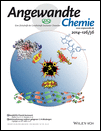Syntheses, Structures, and Reactivities of Two Chalcogen-Stabilized Carbones†
This work was partially supported by a special grant from the College of Industrial Technology, Nihon University. We thank Dr. T. Nakahodo (Kinki University) for the crystallographic analysis of 7.
Abstract
Electronic effects on the central carbon atom of carbone, generated by the replacement of the SIV ligand of carbodisulfane (CDS) with other chalcogen ligands (Ph2E, E=S or Se), were investigated. The carbones Ph2E→C←SPh2(NMe) [E=S(1) or Se(2)] were synthesized from the corresponding salts, and their molecular structures and electronic properties were characterized. The carbone 2 is the first carbone containing selenium as the coordinated atom. DFT calculations revealed the electronic structures of 1 and 2, which have two lone pairs of electrons at the carbon center. The trend in HOMO energy levels, estimated by cyclic voltammetry measurements, for the carbones and CDS follows the order of 2>1>CDS. Analysis of a doubly protonated dication and trication complex revealed that the central carbon atom of 2 behaves as a four-electron donor.




